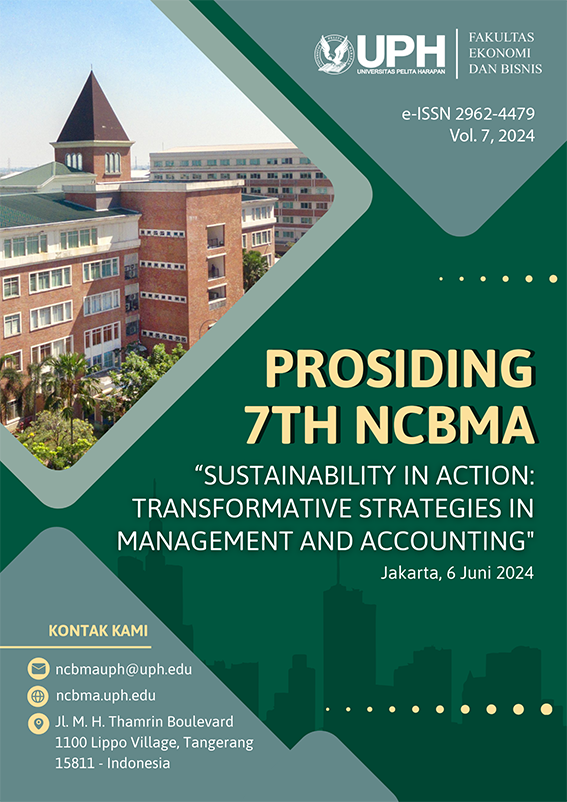SENSITIVITAS ARUS KAS TERHADAP KAS PERUSAHAAN INDONESIA
Keywords:
sensitivitas arus kas, keterbatasan keuangan, asimetriAbstract
Penelitian ini mengkaji apakah sensitivitas arus kas terhadap kas perusahaan di Indonesia bersifat asimetris. Data yang digunakan dalam penelitian ini mencakup 620 perusahaan non-finansial dan non-utilitas di Indonesia selama periode 2009-2021, menghasilkan total 5.360 observasi. Hasil analisis regresi menunjukkan bahwa terdapat asimetri dalam sensitivitas arus kas terhadap kas perusahaan. Ketika perusahaan mengalami arus kas positif, sensitivitas arus kas terhadap kas bersifat negatif. Sebaliknya, ketika perusahaan mengalami arus kas negatif, sensitivitas arus kas bersifat positif. Asimetri ini semakin nyata pada perusahaan yang memiliki keterbatasan akses terhadap keuangan eksternal (keterbatasan keuangan). Temuan ini menegaskan adanya asimetri dalam sensitivitas arus kas terhadap kas dan dampak keterbatasan keuangan eksternal terhadap kebijakan perusahaan di negara berkembang.References
Acharya, V. V., Almeida, H., & Campello, M. (2007). Is cash negative debt? A hedging perspective on corporate financial policies. Journal of Financial Intermediation, 16(4), 515-554. https://doi.org/10.1016/j.jfi.2007.04.001
Allen, F., Qj, J. ", Qian, ", & Qian, M. (n.d.). China’s Financial System: Past, Present, and Future *. http://ssrn.com/abstract=978485
Almeida, H., Campello, M., & Galvao, A. F. (2010). Measurement errors in investment equations. Review of Financial Studies, 23(9), 3279-3328. https://doi.org/10.1093/rfs/hhq058
Amaeshi, K., Adegbite, E., and Rajwani, T. (2016). CorporateSocialResponsibilityinChallengingandNonEnablingInstitutionalContexts (p. journal of business ethics, 134(1):135-153).
Artica, R. P., Brufman, L., & SaguÃ, N. (2019a). Why do Latin American firms hold so much more cash than they used to? Revista Contabilidade e Financas, 30(79), 73-90. https://doi.org/10.1590/1808-057x201805660
Bao, D., Chan, K. C., & Zhang, W. (2012). Asymmetric cash flow sensitivity of cash holdings. Journal of Corporate Finance, 18(4), 690-700. https://doi.org/10.1016/j.jcorpfin.2012.05.003
Bates, T. W., Kahle, K. M., & Stulz, R. M. (2009). Why do U.S. firms hold so much more cash than they used to? Journal of Finance, 64(5), 1985-2021. https://doi.org/10.1111/j.1540-6261.2009.01492.x
Beguin, C., Kulmburg, A., Guignard, J. P., & Rufer, J. M. (1999). 13.The determinants and implications of corporate cash holdings. Journal of Financial Economics, 40(5), 223-228.
Brown, J. R., & Petersen, B. C. (2011). Cash holdings and R&D smoothing. Journal of Corporate Finance, 17(3), 694-709. https://doi.org/10.1016/j.jcorpfin.2010.01.003
Chang, X., Dasgupta, S., Wong, G., & Yao, J. (2014). Cash-Flow Sensitivities and the Allocation of Internal Cash Flow Downloaded from. In RFS Advance Access (Vol. 27). http://rfs.oxfordjournals.org/
Erickson, T., & Whited, T. M. (2000). Measurement error and the relationship between investment and q. Journal of Political Economy, 108(5), 1027-1057. https://doi.org/10.1086/317670
Erickson, T., & Whited, T. M. (2012). Treating measurement error in Tobin’s q. Review of Financial Studies, 25(4), 1286-1329. https://doi.org/10.1093/rfs/hhr120
Faulkender, M., Wang, R., Benzoni, L., Campello, M., Garvey, G., Goldstein, R., Milbourn, T., Petersen, M., & Stambaugh, R. (2006). Corporate Financial Policy and the Value of Cash. In THE JOURNAL OF FINANCE Ӣ: Vol. LXI (Issue 4).
Flor, C. R., & Hirth, S. (2013). Asset liquidity, corporate investment, and endogenous financing costs. Journal of Banking and Finance, 37(2), 474-489. https://doi.org/10.1016/j.jbankfin.2012.09.014
Foda Karim, Shi Y., & Vaziri M. (2022). Financial Constraints, Productivity, and Investment: Evidence from Lithuania D25 E23 016 IMF
Fritz Foley, C., Hartzell, J. C., Titman, S., & Twite, G. (2007). Why do firms hold so much cash? A tax-based explanation. Journal of Financial Economics, 86(3), 579-607. https://doi.org/10.1016/j.jfineco.2006.11.006
Gamba, A., & Triantis, A. (2008). The value of financial flexibility. Journal of Finance, 63(5), 2263-2296. https://doi.org/10.1111/j.1540-6261.2008.01397.x
Grullon, G., Hund, J., & Weston, J. P. (2018). Concentrating on q and cash flow. Journal of Financial Intermediation, 33, 1-15. https://doi.org/10.1016/j.jfi.2017.10.001
Guariglia, A., & Yang, J. (2018). Adjustment behavior of corporate cash holdings: the China experience. European Journal of Finance, 24(16), 1428-1452. https://doi.org/10.1080/1351847X.2015.1071716
Gwatidzo, T., & Ojah, K. (2014). Firms’ debt choice in Africa: Are institutional infrastructure and non-traditional determinants important? International Review of Financial Analysis, 31, 152-166. https://doi.org/10.1016/j.irfa.2013.11.005
Hatefi Majomerd, H., Moradi, M., & Reza Abbaszadeh, M. (2013). The cash flow sensitivity of cash holdings. Advances in Environmental Biology, 7(14), 47954801.
Khurana, I. K., Martin, X., & Pereira, R. (2006). Financial development and the cash flow sensitivity of cash. Journal of Financial and Quantitative Analysis, 41(4), 787-807. https://doi.org/10.1017/s0022109000002647
Kling, G., Paul, S., & Gonis, E. (2012). Cash Holding, Trade Credit and Access to Short-Term Bank Finance. SSRN Electronic Journal. https://doi.org/10.2139/ssrn.1775885
Lei, J., Qiu, J., & Wan, C. (2018). Asset tangibility, cash holdings, and financial development. Journal of Corporate Finance, 50, 223-242. https://doi.org/10.1016/j.jcorpfin.2018.03.008
Machmud, Z., & Huda, A. (2011). Access to Finance: An Indonesia Case Study’, in Selected East Asian Economies. Small and Medium Enterprises (SMEs) Access to Finance in Selected East Asian Economies, September, 261-290.
Machokoto, M., & Areneke, G. (2021). Is the cash flow sensitivity of cash asymmetric? African evidence. Finance Research Letters, 38, 101440. https://doi.org/10.1016/j.frl.2020.101440
McLean, R. D., & Zhao, M. (2018). Cash savings and capital markets. Journal of Empirical Finance, 47, 49-64. https://doi.org/10.1016/j.jempfin.2018.02.001
Riddick, L. A., & Whited, T. M. (2009). The corporate propensity to save. Journal of Finance, 64(4), 1729-1766. https://doi.org/10.1111/j.1540-6261.2009.01478.x
Whited, T. M. (2006). External finance constraints and the intertemporal pattern of intermittent investment. Journal of Financial Economics, 81(3), 467-502. https://doi.org/10.1016/j.jfineco.2005.07.007
Downloads
Published
Issue
Section
License
Copyright (c) 2024 Richeart Widjaja, Liza Handoko

This work is licensed under a Creative Commons Attribution-ShareAlike 4.0 International License.

